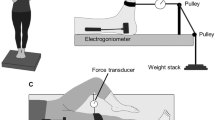Abstract
The aim of this study was to investigate the associations of body factors (anthropometry and foot placement) with postural sway during natural standing and their possible sex differences. Forty young subjects (20 men and 20 women) performed quiet natural standing on a force platform in self-selected feet distance. Five body factors (height, weight, body fat ratio, feet-opening angle, feet distance) were selected as cardinal independent variables from the colinearity analysis. Outcome measures were derived from the center of pressure and included spatiotemporal sway size variables and upper limit frequency of main (95%) power component of sway. Significant sex differences were observed in the correlation of outcome measures with body factors. In women, postural sway size (mean distance and mean velocity) increased with height and weight. In contrast, men showed insignificant change in sway size but significant reduction in sway frequency with height and weight. Stepwise multiple regressions were conducted to investigate the determinants of outcome measures. In case of sway size measures, physique (height and weight) was the major determinant in women but not in men. In case of sway frequency, physique and feet opening angle were the major determinants in men but not in women. Postural control strategy related to body factors is apparently different between sexes, and therefore, extreme care must be taken in normalization of postural sway variables.
Similar content being viewed by others
References
Piirtola, M. and Era, P., “Force platform measurements as predictors of falls among older people-a review,” Gerontology, Vol. 52, No. 1, pp. 1–16, 2006.
Kim, J. W., Kim, C. S., Lee, J. H., Kwon, Y. R., Eom, G. M., Tak, G. R., and Hong, J. H., “Human Postural Control against External Force Perturbation Applied to the High-back,” Int. J. Precis. Eng. Manuf., Vol. 10, No. 4, pp. 147–151, 2009.
Winter, D. A., “Human balance and posture control during standing and walking,” Gait & Posture, Vol. 3, No. 4, pp. 193–214, 1995.
Aoyagi, K., Ross, P. D., Davis, J. W., Wasnich, R. D., Hayashi, T., and Takemoto, T., “Falls Among Community-Dwelling Elderly in Japan,” J. Bone Miner. Res., Vol. 13, No. 9, pp. 1468–1474, 1998.
Cho, C. Y. and Kamen, G., “Detecting balance deficits in frequent fallers using clinical and quantitative evaluation tools,” J. Am. Geriatr. Soc., Vol. 46, No. 4, pp. 426–430, 1998.
Sattin, R. W., “Falls among older persons: a public health perspective,” Annu. Rev. Public Health, Vol. 13, pp. 489–508, 1992.
LaPier, T. L. K., Liddle, S., and Bain, C., “A comparison of static and dynamic standing balance in older men versus women,” Physiotherapy Canada, Vol. 2, pp. 207–213, 1997.
Era, P., Sainio, P., Koskinen, S., Haavisto, P., Vaara, M., and Aromaa, A., “Postural Balance in a Random Sample of 7,979 Subjects Aged 30 Years and Over,” Gerontology, Vol. 52, No. 4, pp. 204–213, 2006.
Bryant, E. C., Trew, M. E., Bruce, A. M., Kuisma, R. M. E., and Smith, A. W., “Gender differences in balance performance at the time of retirement,” Clin. Biomech., Vol. 20, No. 3, pp. 330–335, 2005.
Era, P., Schroll, M., Ytting, H., Gause-Nilsson, I., Heikkinen, E., and Steen, B., “Postural balance and its sensory-motor correlates in 75-year-old men and women: a cross-national comparative study,” J. Gerontol. A Biol. Sci. Med. Sci., Vol. 51, No. 2, pp. M53–M63, 1996.
Era, P., Heikkinen, E., Gause-Nilsson, I., and Schroll, M., “Postural balance in elderly people: changes over a five-year follow-up and its predictive value for survival,” Aging Clin. Exp. Res., Vol. 14,Suppl. 3, pp. 37–46, 2002.
Hue, O., Simoneau, M., Marcotte, J., Berrigan, F., Doré, J., Marceau, P., Marceau, S., Tremblay, A., and Teasdale, N., “Body weight is a strong predictor of postural stability,” Gait & Posture, Vol. 26, No. 1, pp. 32–38, 2007.
Chiari, L., Rocchi, L., and Cappello, A., “Stabilometric parameters are affected by anthropometry and foot placement,” Clin. Biomech., Vol. 17, No. 9–10, pp. 666–677, 2002.
Bonnet, C., Carello, C., and Turvey, M. T., “Diabetes and postural stability: review and hypotheses,” J. Mot. Behav., Vol. 41, No. 2, pp. 172–190, 2009.
Prieto, T. E., Myklebust, J. B., Hoffmann, R. G., Lovett, E. G., and Myklebust, B. M., “Measures of postural steadiness: differences between healthy young and elderly adults,” IEEE Trans. Biomed. Eng., Vol. 43, No. 9, pp. 956–966, 1996.
Corbeil, P., Simoneau, M., Rancourt, D., Tremblay, A., and Teasdale, N., “Increased risk for falling associated with obesity: mathematical modeling of postural control,” IEEE Trans. Neural Syst. Rehabil. Eng., Vol. 9, No. 2, pp. 126–136, 2001.
Jones, K. E., Hamilton, A. F., and Wolpert, D. M., “Sources of signal-dependent noise during isometric force production,” J. Neurophysiol., Vol. 88, No. 3, pp. 1533–1544, 2002.
Kirby, R. L., Price, N. A., and MacLeod, D. A., “The influence of foot position on standing balance,” J. Biomech., Vol. 20, No. 4, pp. 423–427, 1987.
Winter, D. A., Patla, A. E., Prince, F., Ishac, M., and Gielo-Perczak, K., “Stiffness control of balance in quiet standing,” J. Neurophysiol., Vol. 80, No. 3, pp. 1211–1221, 1998.
Henry, S. M., Fung, J., and Horak, F. B., “Effect of stance width on multidirectional postural responses,” J. Neurophysiol., Vol. 85, No. 2, pp. 559–570, 2001.
Author information
Authors and Affiliations
Corresponding author
Rights and permissions
About this article
Cite this article
Kim, J., Kwon, Y., Chung, HY. et al. Relationship between body factors and postural sway during natural standing. Int. J. Precis. Eng. Manuf. 13, 963–968 (2012). https://doi.org/10.1007/s12541-012-0125-0
Received:
Accepted:
Published:
Issue Date:
DOI: https://doi.org/10.1007/s12541-012-0125-0




